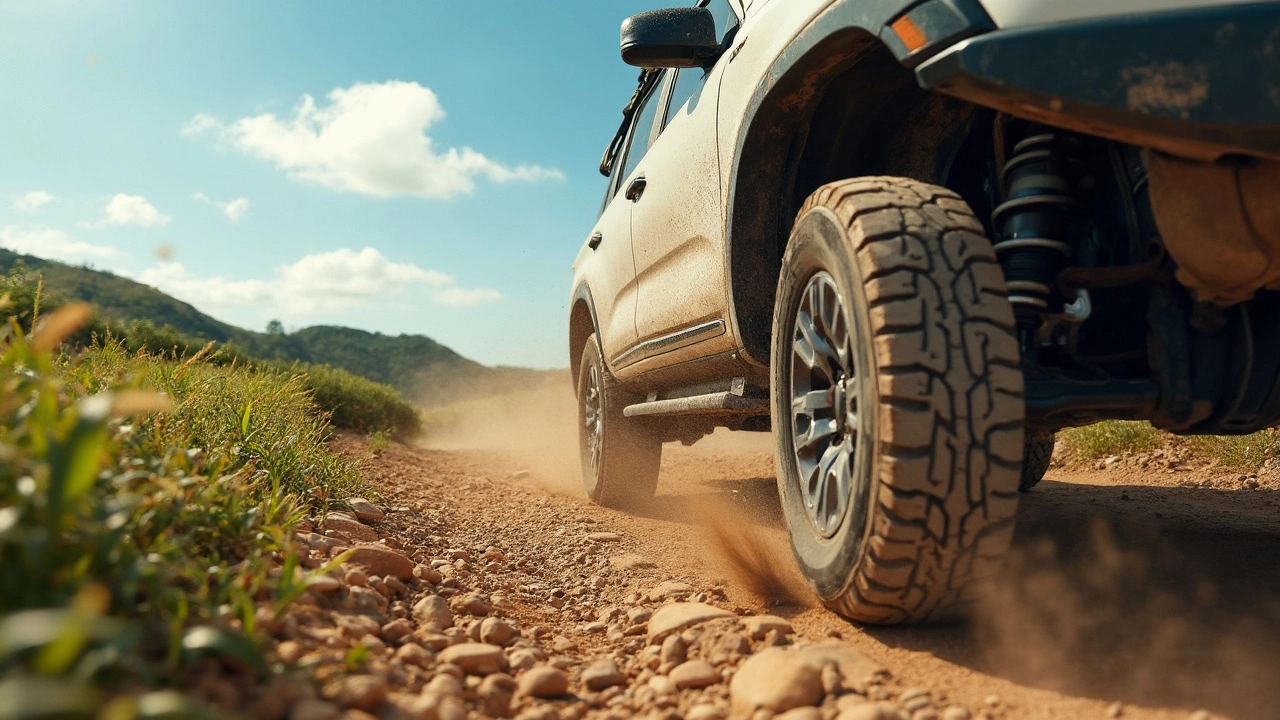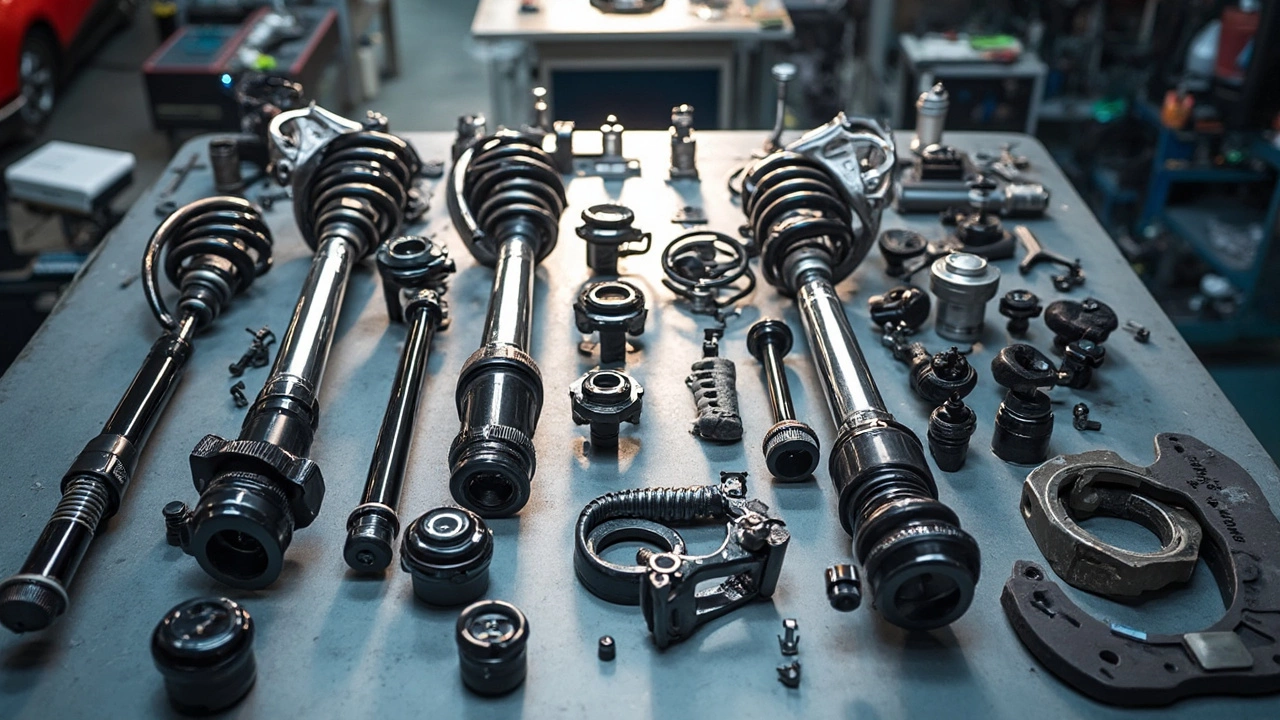Ever feel like your car's front suspension could use a little TLC? Whether you're bouncing around on city streets or tackling rougher terrains, improving your front suspension can make a world of difference. Let's break it down into simple steps.
First things first, get cozy with the basics of your vehicle's suspension system. It's not just about springs and shocks, although they are the stars of the show. Your suspension setup impacts your ride quality, handling, and even safety. Pretty important stuff, right?
Now, before you dive into any upgrades, it's wise to assess what you're working with. Check for any worn-out parts, like bushings or struts, which might need an update. This step is crucial because even the fanciest new parts won't help if the basics are busted.
- Understanding Suspension Basics
- Assessing Your Current Setup
- Choosing the Right Components
- DIY Suspension Upgrades
- When to Consult a Professional
Understanding Suspension Basics
So, you want to get a handle on what makes your car's front suspension tick? Great call. It's the heart of your ride's comfort and responsiveness. In simple terms, your front suspension keeps your tires glued to the road and makes sure your drive feels as smooth as possible. It’s a bit like the car's own personal shock absorber system, softening the blow when you hit bumps or potholes.
The core components you need to know about include springs, dampers (or shocks), and the control arms. Springs support the weight of the vehicle, shocks dampen the up-and-down motion, and control arms support the suspension's movement while holding the wheels in place.
Springs come in various types like coil springs, leaf springs, and torsion bars, but coil springs are most common in front suspension systems. They compress and expand when you drive over uneven surfaces, which helps to absorb bumps.
Dampers or shock absorbers control the bounce your springs can produce, settling your car down after hitting a bump. They operate by converting kinetic energy into heat energy, which is then dissipated, providing a smoother ride.
"A well-tuned suspension can turn an ordinary drive into something that feels like floating on air," says automotive expert Chris Johnson. "It's all about balance."
Another vital part of the system is the control arm, a key player in maintaining the alignment of the wheels with the help of bushings. These ensure that tires are in contact with the road surface for maximum grip.
Here's a neat little stat for you: Improving suspension can enhance handling by up to 50%, according to car enthusiasts who've tweaked their systems to perfection. It shows just how pivotal a role the suspension plays in driving dynamics.
Getting familiar with these basics gives you a solid foundation to make smarter decisions when you start considering upgrades or modifications. Armed with this knowledge, you can identify weaknesses in your current setup and see where adjustments will make the most sense.
Assessing Your Current Setup
Before you get into upgrading, it's smart to see what's already there. Trust me, it's not as dull as it sounds. Whether your car's a weekend racer or your daily ride, knowing the front suspension inside out can save you time and cash.
Start by closely checking the suspension components like springs, shocks, and struts. Look for obvious signs of wear and tear. If you notice uneven tire wear, strange noises, or a bouncy ride, your suspension might be waving a red flag.
Don't forget about the bushings. Those small but mighty parts keep your suspension moving smoothly and silently. If they're dry or cracked, they could be causing play in the suspension.
One quick tip: give your springs a bounce test. Push down on your car's front end and let go—if it keeps bouncing, it's time to replace those shocks or struts.
- Check for leaks around the shocks. Hydraulic fluid leakage is a clear sign they need replacing.
- Look at your tire alignment. If your car pulls to one side, there's a good chance something's off with your suspension.
- Observe the ride height from the side. If one corner looks lower than the others, you might have a sagging spring.
Want to be extra sure? There's no harm in consulting the owner's manual for your car's specs or seeking some wisdom from forums filled with folks who live and breathe cars.
If you're the curious type, here's a little stat for you. Around 65% of suspension issues are first noticed because of that dreaded bumpy ride feel or squeaky sounds. So, keeping your ears peeled is a great tip!

Choosing the Right Components
So, you're ready to roll up your sleeves and upgrade your front suspension. The market is full of options, which can be overwhelming, but choosing the right components makes all the difference. Let's simplify this.
First, decide what you need. Are you looking for improved performance on off-road adventures, or just a smoother ride on your daily route? Your goals should guide your choices.
One of the most impactful components is the shock absorber. Opt for gas-charged shocks if you want a firm, responsive feel. They help in reducing body roll on corners and control over bumpy roads. They're super effective at damping vibrations from uneven surfaces.
Springs are next. You can go for coil springs if comfort is your priority. But for more rugged or performance-based drives, consider lifting or lowering springs that can adjust your vehicle's height and improve handling.
Don't overlook the sway bars. A good sway bar helps reduce body lean during turns, which is crucial for enhanced handling. Thicker sway bars usually provide better stability, but they may slightly stiffen the ride.
Then, there's the matter of bushings. Polyurethane bushings last much longer than rubber ones and reduce unnecessary movements, effectively giving you tighter control.
Here's a quick snapshot of options:
| Component | Best For | Options |
|---|---|---|
| Shocks | Road Comfort & Off-roading | Gas-Charged, Twin-Tube |
| Springs | Performance & Comfort | Coil, Lowering, Lifting |
| Sway Bars | Handling & Stability | Standard, Adjustable |
| Bushings | Durability & Control | Rubber, Polyurethane |
Don’t forget to check compatibility. Not all components fit every vehicle, so consult your vehicle's manual or talk with a professional before purchasing. Investing in the right mix of parts can enhance your suspension upgrade a lot and make your car feel brand new.
DIY Suspension Upgrades
Thinking about tackling some front suspension upgrades yourself? You're not alone, and it's not as intimidating as it may seem. There's a real satisfaction in getting your hands dirty and seeing the improvement in your ride quality.
First, you'll want to ensure you have the right tools. Basic wrenches and sockets are a must, but grabbing a torque wrench can save you from over-tightening bolts—a common mistake for rookies. Safety first, so always use a good jack and jack stands. No one wants to be that guy whose car slipped because a cinder block gave way.
Start with something manageable, like replacing your struts or shocks. These components absorb the bumps and jolts from the road, so upgrading them can really smooth things out. A good set of shocks might make you feel like you're cruising on air.
If you're feeling up to it, roll up your sleeves and try swapping out the bushings. They're the unsung heroes, reducing friction between parts. Polyurethane bushings are a popular choice, as they're more durable than rubber. Installing them can tighten up the handling, making your car feel more responsive.
Here's a quick lowdown on steps to replace shocks:
- Loosen the lug nuts on your front wheels but don't remove them just yet.
- Jack up the car and secure it with jack stands.
- Remove the wheels completely to access the suspension.
- Locate the shocks and remove the top and bottom mounting bolts.
- Take out the old shock and fit in the new one, making sure everything lines up perfectly.
- Tighten the bolts just right—this is where your torque wrench comes in handy.
- Replace the wheel and lower the car back to the ground.
If you've got a bit of cash to splash, consider upgrading to adjustable shocks. They let you tweak the stiffness, offering a customized ride depending on the conditions. Fancy, huh?
One thing to keep in mind: when handling any new parts, pay attention to compatibility with your vehicle's make and model. No one wants to return parts because they're meant for a sedan when you drive an SUV!
Okay, ready to upgrade and feel the thrill of better control on your daily drives? Grab those tools and let's make it happen!

When to Consult a Professional
Sometimes, even the most enthusiastic DIYer might hit a wall with their front suspension. Knowing when to call in the cavalry can save you from headaches and extra costs down the road. Here's when you might want to seek expert help.
If your car suspension involves advanced elements like electronic damping controls or air suspension systems, it might be time to let professionals handle it. These systems can be complex and require specialized tools and software to adjust and repair.
Experiencing consistent or severe problems like persistent squeaks, clunks, or uneven tire wear, despite your best tinkering efforts? This could be a red flag signaling underlying issues beyond a simple DIY fix. Professional mechanics have the experience and diagnostic tools to identify the root cause, saving you trial and error.
Unsure about selecting the right new parts? Professionals can advise on the perfect fit and conductive options based on both your driving needs and your vehicle’s specific requirements. This guidance is particularly valuable when upgrading to performance-level parts where compatibility and precision are key.
Finally, don't underestimate the importance of safety. Suspension work isn’t just about comfort — it’s about ensuring your vehicle handles correctly to keep you and others safe on the road. If you're ever in doubt, it's worth investing in expert help.
